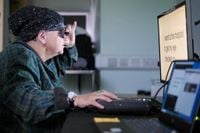At Moorfields Eye Hospital in London, a remarkable medical breakthrough has unfolded, offering hope to thousands who have lost their sight to a once-untreatable condition. Under the steady hand and vision of consultant ophthalmic surgeon Mr Mahi Muqit, a revolutionary eye implant has enabled blind patients to read again—a feat that just a few years ago would have seemed like science fiction.
The heart of this innovation lies in a device no bigger than a pinhead: a 2mm photovoltaic microchip, thinner than a human hair, delicately fitted beneath the retina. This chip, part of the PRIMA system, acts as a bridge between the world and the brain, converting light into electrical signals that the brain can interpret as vision. But the chip doesn’t work alone. Patients don special glasses equipped with a miniature camera. These glasses capture images and transmit them via an infrared beam to the implant, which then stimulates the retina, sending visual signals along the optic nerve to the brain. It’s a high-tech relay race, and the finish line is nothing short of a restored sense—sight itself.
The PRIMA system, developed by a California biotechnology company, has been at the center of an ambitious international trial spanning five European countries, including the UK, France, Italy, and the Netherlands. According to Sky News, the global trial involved 38 patients across 17 sites, all of whom suffered from geographic atrophy (GA), an advanced form of dry age-related macular degeneration (AMD). This degenerative disease, which affects more than 250,000 people in the UK and five million worldwide, destroys the macula—the small, central part of the retina responsible for sharp, detailed vision—leaving patients with only blurry peripheral sight.
For those with GA, the world shrinks to a blur. Reading, writing, recognizing faces—all become Herculean tasks. But the PRIMA implant has changed that narrative for many. In the recently published results of the international study, more than four out of five participants regained meaningful central vision. Specifically, 27 of the 32 patients who received the implant were able to read letters, words, and numbers after years—sometimes decades—of blindness. On standard eye-chart tests, participants improved by an average of five lines, equivalent to 25 additional letters. As BBC reported, these gains represent not just numbers on a chart, but real changes in daily life: reading mail, deciphering prescription labels, and even tackling crosswords and Sudoku puzzles.
One of the most compelling stories to emerge from the trial is that of Sheila Irvine, a 70-year-old from Wiltshire. Decades ago, Sheila lost her sight to advanced dry AMD. Before the operation, she described her vision as "like having two black discs" in her eyes, with the outside distorted. "I am unable to read even the largest street signs when outdoors," she told BBC. Life shrank to a narrow, blurry tunnel. Yet after receiving the implant at Moorfields, Sheila can now read her post, complete crosswords, and even tackle Sudoku. "It's beautiful, wonderful. It gives me such pleasure," she said, beaming after flawlessly reading an eye chart during her assessment. "I am one happy bunny."
The procedure itself is a marvel of modern surgery. Surgeons perform a vitrectomy—removing the jelly-like substance inside the eye—before placing the tiny chip under the retina. The operation typically lasts under two hours and, according to Sky News, was performed at Moorfields Eye Hospital around three years ago for the UK patients. After implantation, patients undergo months of rehabilitation to learn how to interpret the new visual patterns. This process, blending neuroplasticity and digital vision technology, requires dedication and patience. Sheila, for instance, uses a pillow under her chin to steady the camera feed and often switches the device to magnification mode to distinguish between similar letters.
While the PRIMA system does not restore natural vision—nor does it help those born blind with undeveloped optic nerves—it represents a quantum leap for those with degenerative central vision loss. As Mr Muqit explained to BBC, "This is the first implant to give patients meaningful vision they can use in daily life, such as reading and writing. It’s a major step forward in restoring functional sight to people who had lost all hope." He described the results as "pioneering and life-changing technology."
The technology is not only about hardware but also about software. The glasses’ built-in camera is linked to a small computer worn on the waistband, which processes images using artificial intelligence. The computer converts these images into signals that the chip can interpret, which are then sent through the retina and optic nerve to the brain. This digital enhancement is crucial, as the images must be clear and interpretable for the patient to make sense of them. As BBC illustrated, the difference between a blurred word and a bold, high-contrast one can mean the difference between confusion and understanding.
Behind this breakthrough stands Mr Mahi Muqit, a Consultant Vitreoretinal Surgeon at Moorfields and an Honorary Clinical Lecturer at the UCL Institute of Ophthalmology. With a background in retinal imaging and diabetic eye disease, Mr Muqit has dedicated his career to bridging the gap between laboratory innovation and tangible patient benefit. His work has been instrumental in developing surgical methods for retinal detachment, macular repair, and now, implantable vision prosthetics. As he told Sky News, "In the history of artificial vision, this represents a new era. Blind patients are actually able to have meaningful central vision restoration, which has never been done before."
Yet, as with all cutting-edge technology, there are hurdles ahead. The PRIMA implant is still awaiting regulatory approval before it can be offered through the NHS. But optimism runs high. Mr Muqit believes that, with continued refinement and cost-reduction, the implant could become available to NHS patients within the next few years. Future generations of the device are expected to offer wider fields of view, improved image processing, and deeper integration with adaptive artificial-intelligence systems to further enhance visual interpretation. Dr Peter Bloomfield, director of research at the Macular Society, called the results "encouraging" and "fantastic news" for those who currently have no treatment options. "Artificial vision may offer a lot of hope to many, particularly after previous disappointments in the world of dry AMD treatment," he said to BBC.
The implications are profound. For patients once consigned to permanent darkness, the return of the written word is nothing short of miraculous. As Sheila herself put it, "Technology is moving so fast, it's amazing that I am part of it." For Mr Muqit and his team at Moorfields, the PRIMA implant is more than a scientific achievement—it is a glimpse of a future where sight, once lost, might one day be fully restorable.

